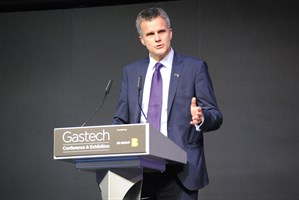Gastech ’15: BG Group’s CEO sees “the end of boom and bust”
10/26/2015 12:00:00 AM
By KURT ABRAHAM
Gulf Publishing
SINGAPORE -- Recognizing that the dominant theme at the moment is uncertainty, BG CEO Helge Lund told Gastech attendees during his keynote address this week, “I believe in the long-term future of our industry; I remain an optimist about the role of gas in the energy mix.”
 Three years ago, at Gastech in London, the conference discussion was about how LNG and shale gas were changing the industry, Lund noted. “The sharp fall in commodity prices has created volatility and challenged profitability and return across the sector,” he added. “Everyone in the industry has been impacted, including my own company.”
Three years ago, at Gastech in London, the conference discussion was about how LNG and shale gas were changing the industry, Lund noted. “The sharp fall in commodity prices has created volatility and challenged profitability and return across the sector,” he added. “Everyone in the industry has been impacted, including my own company.”At the same time that prices remain low, continued Lund, “stakeholders are also calling on all of us to explain how we will manage our businesses in a lower-carbon world. It is not a comfortable time to be in energy. But, it is a moment when we have the opportunity to look afresh at what we do.” Lund said that his firm continues to see LNG and shale gas shaping the markets, and that gas has an exciting future.
The long-term future. Taking a jab at industry critics, Lund declared, “This is not a twilight industry, but one I believe will continue to develop, as we provide the answers to key global economic and societal challenges. But, this future also requires us to accept that business-as-usual is no longer an option.”
The BG chief confirmed that long-term fundamentals for energy remain strong. He noted that the IEA estimates that energy demand will expand by at least 37% by 2040, with oil and gas making up around 50% of the energy mix in 2040. This compares with a 53% share at present.
Additionally, said Lund, the world will need an extra 42 MMboed to meet this demand—even without replacing the natural decline in existing fields.
“If we look at gas alone, the growth profile is even stronger,” continued Lund. “The IEA forecasts gas usage will increase by 55% by 2040, or roughly 31 MMboed. LNG will be a major factor in that growth.”
He added that BG’s own forecast is for LNG volumes to grow between 4% and 6%, on average, every year to 2025. Most of this growth will come from China, India and Southeast Asia.
Chinese market. Taking a look at specific markets, Lund noted that gas accounts for only about 5% of the energy fuel mix in China today. “We know that this will grow,” he opined. “China has committed itself to improving its air quality. The government has announced plans to cap carbon emissions by 2030, and expand its carbon trading mechanism across the whole country by 2017," Lund explained.
"That latter item—air quality—will require a change to the fuel mix,” he continued. “The share of gas has to increase by replacing coal in homes, factories and in the power sector. LNG will be a key source of supply of this gas to China, as well as to many other markets globally.”
Global trends. Lund said that it is BG’s view that LNG will ultimately drive the globalization of the natural gas industry. At the moment, LNG represents 10% of global gas consumption and 30% of internationally traded gas. In addition, he thinks that the LNG industry is about to “press the fast-forward button on its evolution.”
There are two key drivers in this evolution, Lund explained. "First, significant volumes of new US LNG exports are about to come onstream. In our view, this will change the game, particularly with regard to flexibility and liquidity of supply. Second, we are seeing not just rapid growth, but also a diversification of demand. More countries are starting to import LNG, and multiple buyers are emerging in markets that previously lacked energy competition.”
Efficiency and cost-cutting. Lund also issued a call for more efficient operations. “I believe the fall in prices is actually only a marker for a larger trend—our industry’s undisciplined decision-making over the past decade.” Between 2004 and 2014, capital expenditures rose 10% per year, and operating costs jumped by 5%, he said.
“Put another way, in 2014, IOCs were spending more than twice as much as they had in 2004 to produce the same volumes of oil and gas,” explained Lund. He said that the industry forgot about—or did not pay sufficient attention to—what it needed to manage in the short term, like cost efficiency, return and cashflow generation. He called for greater efficiency and standardization of operations and technologies employed. He said that the three key elements to succeeding on these points will be discipline, innovation and people.
In summation, Lund noted, “As an industry, we face a big and challenging agenda. But this is an industry that is used to making the impossible, routine." To drive home that point, Lund quoted Winston Churchill, who he described as "a leader well-accustomed to seemingly insurmountable challenges": A pessimist sees the difficulty in every opportunity, but an optimist sees opportunity in every difficulty.
Gastech 2015 continues through Friday in Singapore. As the official conference newspaper provider, stick with Hydrocarbon Processing for continued live coverage from the event.






Comments